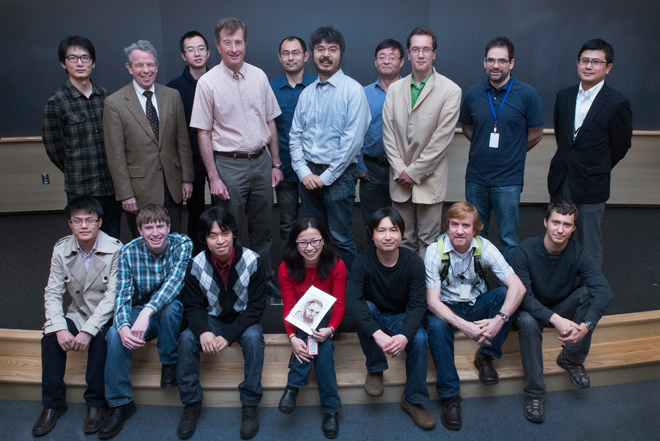Research Facility Development Division
- Accelerator Group
- Accelerator R&D Team
- Ion Source Team
- RILAC Team
- Cyclotron Team
- Beam Dynamics & Diagnostics Team
- Cryogenic Technology Team
- Infrastructure Management Team
- Research Instruments Group
- Automated Operation Technology Team
- BigRIPS Team
- SAMURAI Team
- Data System Team
- Detector Team
- Instrumentation Development Group
Nuclear Science Research Division
- Radioactive Isotope Physics Group
- Nuclear Dynamics Research Group
- Few-body Systems in Physics Laboratory
- Cosmic Radiation Laboratory
- Astro-Glaciology Research Unit
- Nuclear Many-body Theory Laboratory
- RHIC Physics Research Group
- Three-Body Nuclear Force Laboratory
- Meson Science RIKEN ECL Research Team
Accelerator Applications Research Division
Directly under the Nishina Center
Closed Laboratory
Computing Group

Staff

Research Areas
The computing group founded in 2011 as a part of of the RIKEN BNL Research Center established at Brookhaven National Laboratory in New York, USA, and dedicated to conduct researches and devlopements for large scale physics computations important for particle and nuclear theory. The main subjects include the lattice gauge theory, such as lattice QCD describing the sub-atomic structures of hadrons, which allow us the ab-initio investigation for strongly interacting quantum field theories beyond pertrubative analysis. The three of the major activities are R&D for high performance computers, developments for computing algorithms, and researches of particle, nuclear, and lattice theories.
In 1997, the group pioneered the use of the domain-wall fermions, which preserve chiral symmetry, a key symmetry for understainding nature of paritcle nuclear physics, and investigate various hadron physics including an important calculation of quark flavor mixing and CP-violations or hadronic contributions to muon's anomalous magnetic moment (g-2) that are relevant for checking the standard model of particle nuclear physics utilizing the Cabibbo-Kobayashi-Maskawa theory. In JFY2004, the numerical lattice QCD group built a 10 TFlops QCDOC parallel supercomputer dedicated for the first-principle non-perturbative calculations of QCD. A total 600 teraflop (peak) successor to the QCDOC computer, three racks of QCDCQ (QCD with Chiral Quarks), is installed and starts to run new physics programs.
Research Subject
- High performance computers for particle nuclear physics
- Algorithms for computings in particle nuclear physcs
- Particle, Nuclear, and lattice field theories
List of Selected Publications
- T. Blum, N. Christ, M. Hayakawa, T. Izubuchi, L. Jin, C. Jung and C. Lehner.:
"Connected and leading disconnected hadronic light-by-light contribution to the muon anomalous magnetic moment with phys- ical pion mass"
Physical Review Letteters Volume 118, Article 022005, (2017)
- T. Blum, P. A. Boyle, T. Izubuchi, L. Jin, A. Jüttner, C. Lehner, K. Maltman, M. Marinkovic, A. Portelli, and M. Spraggs (RBC and UKQCD Collaborations).:
"Calculation of the Hadronic Vacuum Polarization Disconnected Contribution to the Muon Anomalous Magnetic Moment"
Physical Review Letters Volume 116, Article 232002, (2016)
- Z.Bai,T.Blum,P.A.Boyle,N.H.Christ,J.Frison,N.Garron,T.Izubuchi,C.Jung,C.Kelly,C.Lehner, R. D. Mawhinney, C. T. Sachrajda, A. Soni, and D. Zhang (RBC and UKQCD Collaborations).:
"Standard Model Prediction for Direct CP Violation in K → ππ Decay"
Physical Review Letters Volume 115, Article 212001 (2015) [ Editors' suggestion ]
- Michael G. Endres, Andrea Shindler, Brian C. Tiburzi, Andre Walker-Loud.:
"Massive photons: an infrared regularization scheme for lattice QCD + QED"
Physical Review Letters, Volume 117
- T. DeGrand, M. Golterman, W. I. Jay, E. T. Neil, Y. Shamir and B. Svetitsky.:
"Radiative contribution to the effective potential in composite Higgs models from lattice gauge theory"
Phys. Rev. D94:5, 054501 (2016)
- Thomas Blum, Saumitra Chowdhury, Masashi Hayakawa, Taku Izubuchi.:
"Hadronic light-by-light scattering contribution to the muon anomalous magnetic moment from lattice QCD"
Phys.Rev.Lett. 114 (2015) 1, 012001, arXiv:1407.2923.
- Thomas Blum, Taku Izubuchi, Eigo Shintani.:
"A new class of variance reduction techniques using lattice symmetries"
Phys.Rev.D88 (2013) 094503 (6 pages)
- Tomomi Ishikawa, Thomas Blum, Masashi Hayakawa, Taku Izubuchi, Chulwoo Jung, Ran Zhou.:
"Full QED+QCD Low-Energy Constants through Reweighting"
Phys.Rev.Lett. 109 (2012) 072002 (5 pages).
- S. Meinel.:
"Λc → Λl+νl form factors and decay rates from lattice QCD with physical quark masses"
Phys. Rev. Lett. 118, no. 8, 082001 (2017)
- Yasumichi Aoki, Taku Izubuchi, Eigo Shintani, Amarjit Soni.:
"Improved lattice computation of proton decay matrix elements"
arXiv:1705.01338




